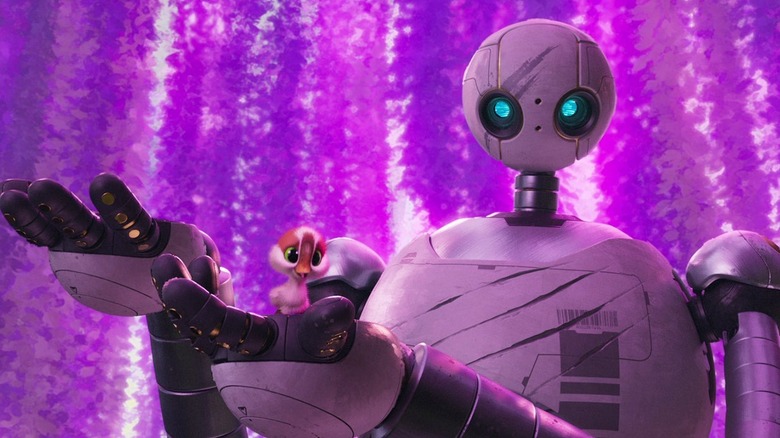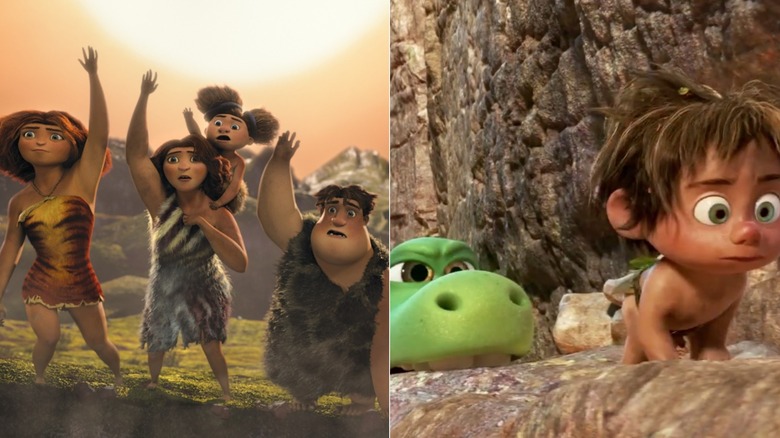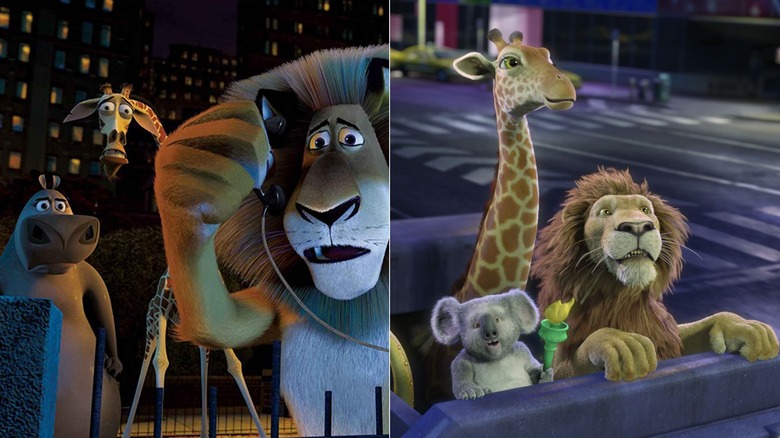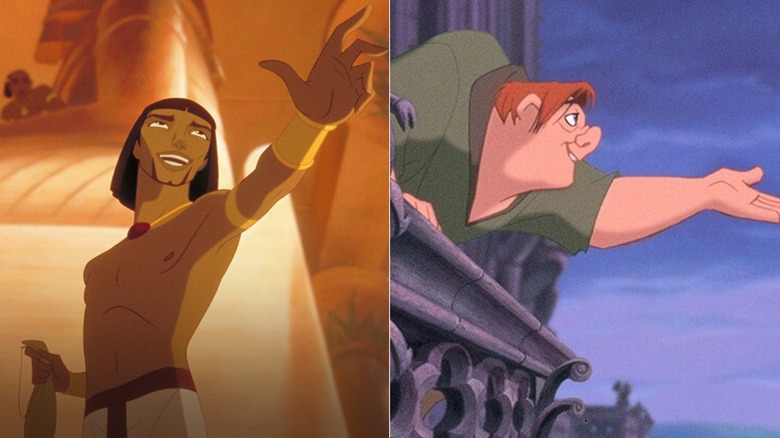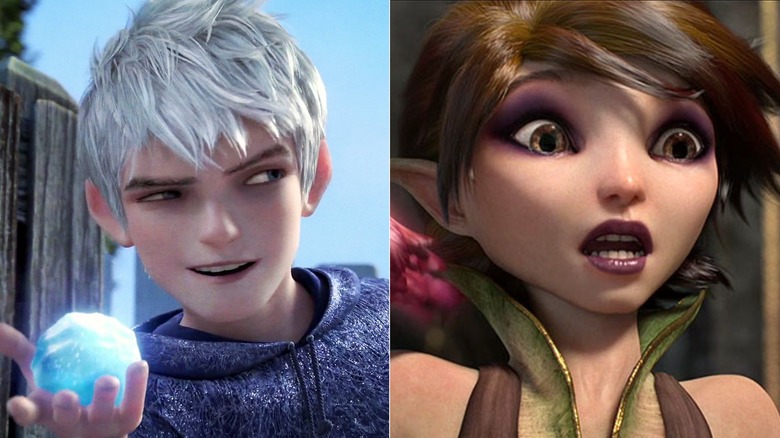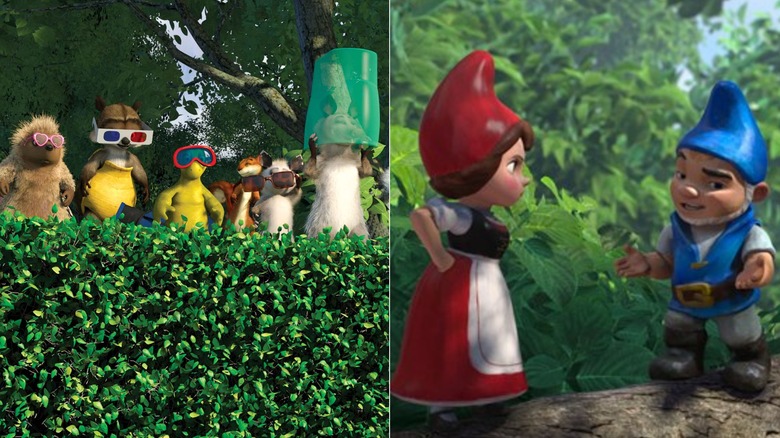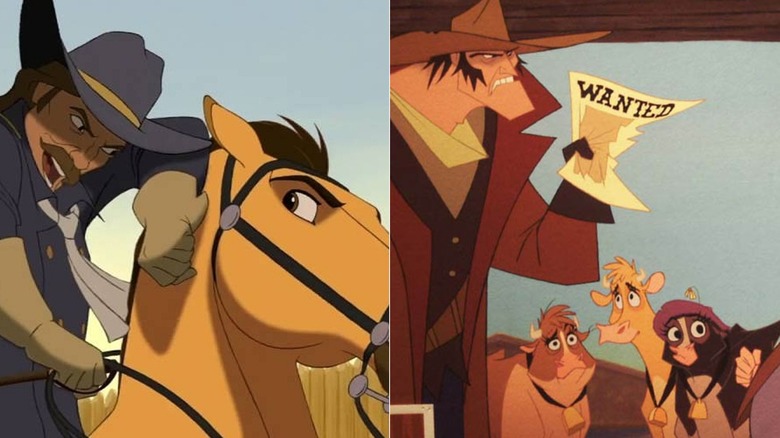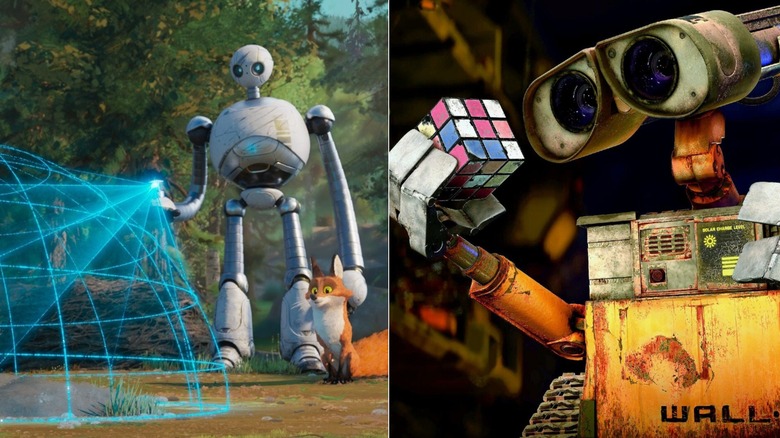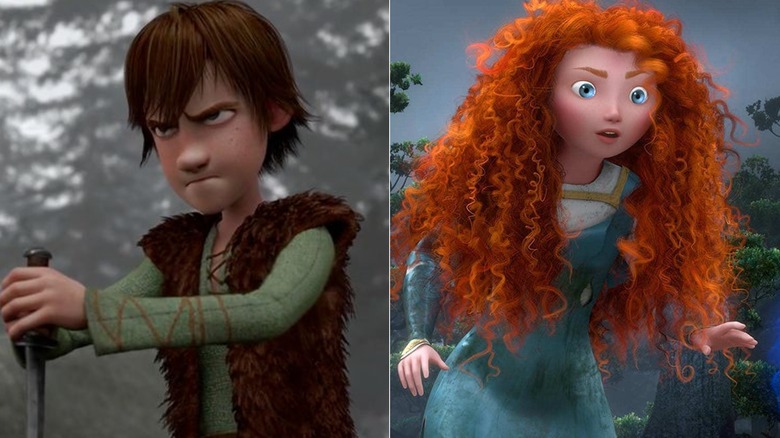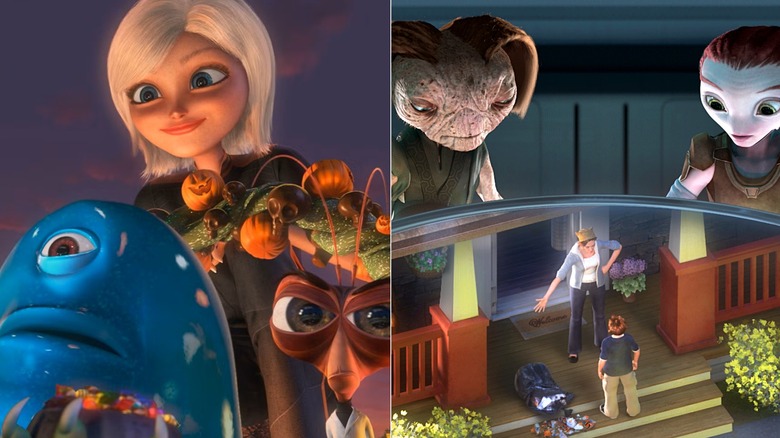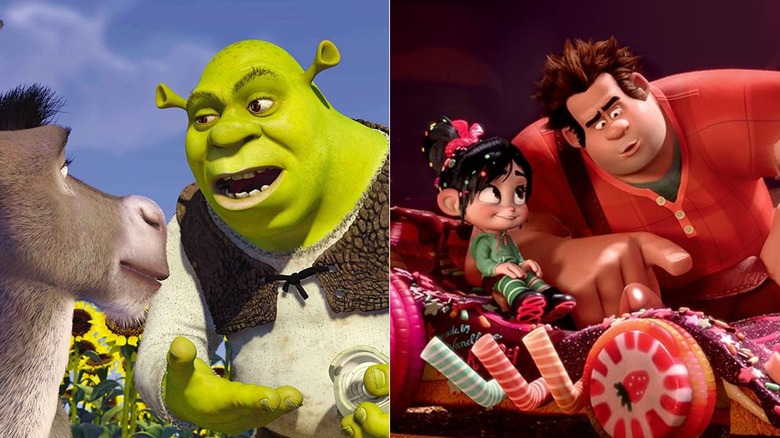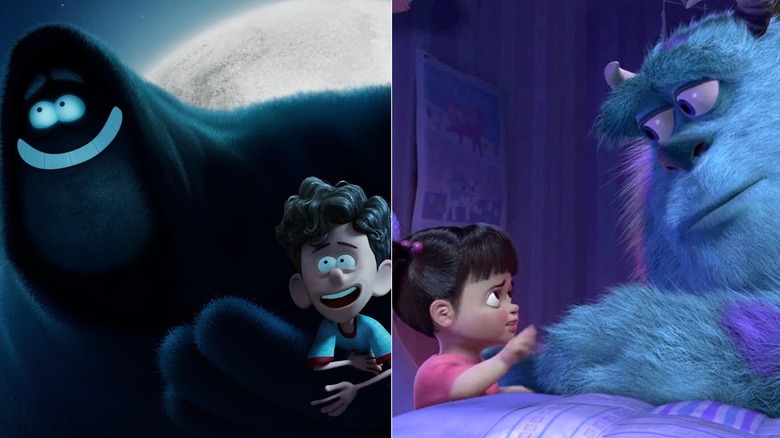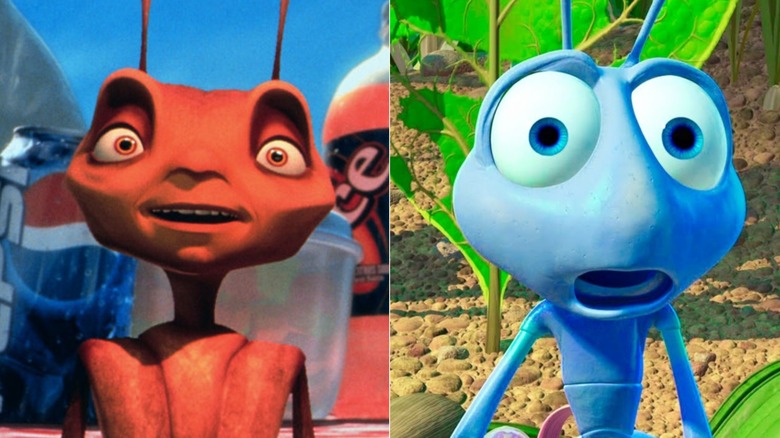12 DreamWorks Animation Movies That Are Better Than Disney Projects
For as long as animated movies have existed, Disney has reigned over the medium virtually unchallenged. There have been a few dicey periods, certainly — and as of this writing, there are a whopping 16 Disney animated movies with a rotten score. In addition, the likes of Warner Bros., Illumination, Nickelodeon, and a few other studios occasionally have big enough hits to make the house that Mickey built nervous. But for the most part, Disney — especially after bringing Pixar under its umbrella — has never been consistently challenged in that arena for any length of time. That is, until DreamWorks Animation entered the picture.
Not only has DreamWorks slowly built a strong portfolio of animated properties over the last 30 years, it hasn't been afraid to directly go up against Disney on multiple occasions. There are several DreamWorks animated movies that feel like direct responses to a Disney film, sometimes one that was just released a year or two prior. On the flipside, DreamWorks has sometimes been the first out of the gate with a new idea, one that did so well and became enough of a part of the zeitgeist that Disney seemed to directly respond with its own version of said idea. Either way, DreamWorks has been the creative — and sometimes, even commercial — victor in many of those matchups.
The Croods is better than The Good Dinosaur
When looking at all Pixar movies ranked worst to best, the studio's worst non-sequel, non-spinoff to date is "The Good Dinosaur." Sure, imagining a world where dinosaurs never went extinct, causing them to be the ones to intellectually evolve rather than humans, was novel enough. But "The Good Dinosaur" saw Pixar seeming to take more direct aim at small children then it ever had before, and it remains the studio's most slight and simple effort to date as a result.
Worse is that DreamWorks had already beaten Pixar to the prehistoric punch two years earlier with "The Croods." It follows the titular family who are living in the movie's fictional Croodaceous era, a creative decision that allowed for the filmmakers to have a lot more fun with the story as well as introduce different creatures that aren't just the standard dinosaur/sabretooth tiger/mammoth fare. It also let them play fast and loose with where human achievement was at that point in the movie's timeline.
Most crucially of all, "The Croods" actually has interesting characters that you care about, while you'd be hard pressed to even name "The Good Dinosaur"'s main dino and his human companion an hour after it's over.
Madagascar is better than The Wild
The "Lion King" controversy Disney probably doesn't want you to remember involved accusations that the movie's basic plot wasn't a wholly original one. Disney might have built much of its animated movie empire on stories and characters it either adapted with permission, or simply helped itself to thanks to them being public domain, but rarely has the company been accused of so blatantly ripping off another thing and hoping nobody would notice. That being said, it wouldn't be the last time it happened — though in the case of 2006's "The Wild," the movie was such a critical and commercial disappointment that nobody cared enough to sue.
Just how similar is "The Wild" to DreamWorks's "Madagascar?" Well, Claudia Puig of USA Today called it, "the most wildly derivative animated movie in ages." More than just sharing an anthropomorphic animal cast with "Madagascar," both movies are specifically about animals from the Central Park Zoo who find themselves in Africa and go on misadventures as they adjust to their new situation. But while it's admittedly a mid-tier DreamWorks effort, "Madagascar" is still significantly better than "The Wild," with the former more than tripling the paltry 18% Rotten Tomatoes score that Disney's copycat effort scratched by with.
Even the animation in "The Wild" — which is usually the one area where Disney animated films generally manage to outdo its competition — was shockingly subpar for a theatrical animated film from any studio in 2006.
The Prince of Egypt is better than The Hunchback of Notre Dame
Disney seemed to be on a historical kick in the latter half of the '90s, kicked off with 1996's "The Hunchback of Notre Dame" — set in 16th century France and based on the famed Victor Hugo novel of the same name. It of course needed the Disney treatment, meaning upbeat songs and wisecracking gargoyle pals. And the original story's rougher edges were smoothed out as it told the tale of a recluse named Quasimodo (Tom Hulce) who dares to venture out in public and is immediately mocked and shunned by the locals.
Still in its formative years, DreamWorks took a similar route to source material in the late '90s and into the early 2000s. This began with "The Prince of Egypt," a 1998 film that tells a version of Moses's journey from prince to prophet as told in the Book of Exodus. While there are also songs in "Prince of Egypt," they felt more tonally appropriate to the film rather than "The Hunchback of Notre Dame" and its shoehorning of feel-good Disney tunes into a dark, Gothic story. Likewise, "Prince of Egypt" is appropriately family-friendly and lightens things up a bit from its source material, but not to such an extent that it seems to completely betray its original spirit and message.
While "Hunchback" is all but forgotten these days, "Prince of Egypt" continues to see positive reappraisals and has enjoyed several instances of cultural resurgences, including a particularly noteworthy one that occurred during the COVID-19 pandemic.
Rise of the Guardians is better than Strange Magic
Once George Lucas sold "Star Wars" to Disney in 2012, he's only had executive producer credits and nothing else. That is, with the exception of Disney's 2015 animated movie "Strange Magic," a project that Lucas had been kicking around for 15 years. He ultimately only served as the movie's story writer, letting others handle screenplay and directing duties. The fantasy adventure sought to be a new kind of fairytale, with classic tropes reinvented for a modern audience. Unfortunately, "Strange Magic" is the worst kind of swan song for a creative figure — it was absolutely decimated by critics and a massive box office flop.
DreamWorks had already had a better handle on fantasy action than Disney did in the 2010s, and more specifically, had beaten "Strange Magic" to the punch of making old things feel new again. "Rise of the Guardians" took classic folklore figures Santa Claus, the Easter Bunny, the Boogeyman, the Sandman, and Jack Frost and made them into an Avengers-like squad who secretly protect the world from evil. It not only made "Strange Magic" look superfluous before that movie even came out, but "Rise of the Guardians" also succeeded in being the perfect kid-friendly alternative to the growing world of comic book films that could often feel a little too big and scary for the younger demos.
Over the Hedge is better than Gnomeo & Juliet
While a few animated films have turned to William Shakespeare for very loose inspiration — "The Lion King" borrows elements of "Hamlet," for instance — it wasn't until "Gnomeo & Juliet" in 2011 that one wore its connection to The Bard on its sleeves. This time, the Montagues and the Capulets are families of garden gnomes in neighboring yards, and the titular duo don't meet at a party but instead while both are going on secret misadventures. Other characters include plastic flamingos, garden sprinklers, and even a William Shakespeare statue voiced by Patrick Stewart. Oh, and the whole thing is set to Elton John songs, with the musician and his husband serving as executive producers.
Overall, "Gnomeo & Juliet" is pretty cute, but it doesn't come anywhere close to the DreamWorks entry in the world of adventure/heist films that take place in and around backyards. Its entry is "Over the Hedge," released five years earlier and enjoying both higher critical praise and a much more impressive box office. It follows a shifty racoon who enlists a family of squirrels to help him make good with a bear after having previously gotten on that bear's bad side. That raccoon, RJ (voiced by Bruce Willis), also feels very much like he directly inspired Disney's conman Nick the fox (Jason Bateman) in "Zootopia."
Spirit: Stallion of the Cimarron is better than Home on the Range
Do you know what kids want to see more than anything else? Animated movies that paid tribute to classic Westerns! But in all seriousness, it's been a longstanding tradition to have animated films use the Old West as a backdrop, as it offers a pretty solid foundation with which to build a good vs. evil adventure story with talking animals. The animated rivals both took a stab at this around the same time with DreamWorks' "Spirit: Stallion of the Cimarron" in 2002 and Disney's "Home on the Range" in 2004.
"Home on the Range" takes things in a slightly more obvious direction, having three cows take on a cattle rustler and sing snappy songs in the process. "Spirit" opts to be a little more serious and not fall back on as many talking animal movie conventions in its tale of a horse who bonds with the Lakota man who freed him from capture by the United Stats Calvary. As Roger Ebert pointed out in his three-star review, "Spirit" is "uncluttered by comic supporting characters and cute sidekicks." And it's that difference that makes "Spirit" not only the superior film, but the better entry point for young children into the Western genre, which is what both movies certainly had in mind.
The Wild Robot is better than WALL-E
There's no denying that Pixar's "WALL-E" is not only one of the best Disney movies, but one of the best animated movies of all time, period. Spending a good chunk of its runtime being virtually dialogue-free, the movie's brilliance comes in the way it conveys its plot and fully develops its characters almost entirely through showing rather than telling. For a character that not only can't say anything but his own name, but has treads instead of legs, WALL-E is one of the most endearing — and most human — animated characters in recent memory.
So when we say that DreamWorks's "The Wild Robot" is even better than "WALL-E," it's a significant statement to make. The films have similar plots: Both see robots in a human-less world that aren't supposed to feel human emotions, but learn to have them anyway, and choose to ignore their programming for the sake of the loved ones they've unexpectedly gained along the way.
Where "WALL-E" falters is in the surprise introduction of the humans, and going a little too hard on the preachy message of how technology is going to make us all so lazy one day that we'll live our entire lives as sedentary blobs. "The Wild Robot" instead doesn't even bother with humans at all, keeping the focus entirely on the battle between technology and nature. Ironically, that ends up giving "The Wild Robot" even more humanity.
How to Train Your Dragon is better than Brave
As previously mentioned, there seemed to be something of a shift in the medium of animated films going into the 2010s, in the direction of action and fantasy. And DreamWorks effectively kicked that off right at the start of the decade with 2010's excellent "How to Train Your Dragon." Though the studio had already done action — and did it very well — with "Kung Fu Panda" two years prior, "How to Train Your Dragon" felt like DreamWorks really turning a corner into the big leagues of animated films and putting Disney on notice. Two years later, Disney seemed to answer with Pixar's "Brave."
Both movies take place in small, close-knit towns in the middle ages, both exist in a world where magic and magical beings exist, and both star a protagonist who doesn't seem equipped nor especially interested in fulfilling the destiny thrust upon them but rise to the occasion nonetheless. However, "Brave" loses its way a bit after a strong start when it becomes about a girl trying to turn her mother back into a human after she's transformed into a bear.
"How to Train Your Dragon" not only stays more narratively consistent and thematically cohesive, but Hiccup (Jay Baruchel) bonding with dragon Toothless is a far sweeter and more engrossing tale than Merida (Kelly McDonald)'s misadventures with her mom-turned-bear.
Monsters vs. Aliens is better than Mars Needs Moms
It took awhile for Disney to do much experimenting with sci-fi in its animated films. And even when it first dabbled in it, it was often with a huge creative safety net — like how "Treasure Planet" was a space movie but wrapped in the familiar blanket of ships and pirates. One of the company's first straight-up sci-fi animated movies that wasn't also something fairly familiar was 2011's "Mars Needs Moms," a story about a boy named Milo (voiced by Seth Dusky, but with mo-cap work by Seth Green) who has to save his mother from the Martians. They're looking to extract her life force while also teaching Martians about love between a parent and a child.
"Mars Needs Moms" was a very expensive production, and went on to become one of the biggest box office bombs that has ever been released with the Disney name attached. The problem is that it was all style and no substance, a marvel to look at but without the heart and soul to match. Meanwhile, DreamWorks had its first foray into sci-fi two years earlier with "Monsters vs. Aliens," not only far better liked but a big enough hit to spawn a TV series, shorts, and more. Choosing a lighter approach to the genre, as well as not overthinking its premise — it's essentially exactly what its title says it is — worked out for the best here.
Shrek is better than Wreck-It Ralph
It didn't take long for DreamWorks Animation to get its first superstar mascot in Shrek, the title character in the studio's massively successful 2001 film. Having original, beloved characters like Shrek (Mike Myers) and Donkey (Eddie Murphy) was the secret sauce that DreamWorks had been missing with its first few efforts and what was needed to finally stake its claim in the medium.
It might not immediately seem like Shrek has a lot in common with the title character of "Wreck-It Ralph," but both are big, oafish characters who are initially villain types but reluctantly learn to be good guys in the end — with a lot of help from spunky sidekicks who never shut up in the process. And as great of a character as Ralph is, and as awesome as his movie is, neither hold a candle to "Shrek" or its green-skinned protagonist. It's also worth mentioning that "Shrek 2" was just as good as, if not better, than its predecessor, while "Ralph Breaks the Internet" was generally seen as pretty good but ultimately a step down from the original.
Orion and the Dark is better than Monsters, Inc.
Both DreamWorks and Disney have excellent movies that tackle the conceit of monsters that live in kids' closets, under the bed, and in their dreams, who are discovered to actually care about their charges rather than truly wanting to scare them. On the Disney side, Pixar's "Monsters, Inc." sees monsters Sulley (John Goodman) and Mike (Billy Crystal) accidentally let a human child into the monster world, but choose to protect her rather than turn her in. And DreamWorks's "Orion and the Dark" follows a nervous boy named Orion (Jacob Tremblay) who befriends the physical embodiment of his fear of the dark as the pair go on an adventure that helps both of them learn to be less afraid.
"Monsters, Inc." is a certified classic, and even among other Pixar movies it is tough to beat. This matchup certainly doesn't see one movie being hugely better than the other. But "Orion and the Dark" edges it out just a bit by the human charge not just being a gibberish-talking toddler and therefore offering the opportunity for a more developed bond between Orion and Dark than the one between Sulley and Boo.
Antz is better than A Bug's Life
This remains one of the most infamous examples in movie history of two shockingly similar movies coming out at almost the same time. The behind-the-scenes shenanigans that caused Disney to release a movie called "A Bug's Life" the same year DreamWorks released a movie called "Antz" is a fascinating story, one that is far too complex to get into here. Suffice it to say that both movies are about talking insects who come to reject their predetermined path in life and figure out a way to break free from said path.
Unlike most other examples of this type of thing happening, there's no clear consensus as to which is the better movie. They even have identical Rotten Tomatoes scores. But those that give the edge to "Antz," like we do, fall that way because it's the scrappier and edgier film, one whose stakes feel a little more significant and whose message is a bit more relatable to the real world. And while "A Bug's Life" earned an automatic legacy by way of the Disney marketing machine, "Antz" has unfortunately found itself increasingly overlooked among the most underrated animated movies ever. Even if you don't happen to think "Antz" is the better movie, it's definitely the one more in need of being rediscovered and not forgotten as time goes on.
